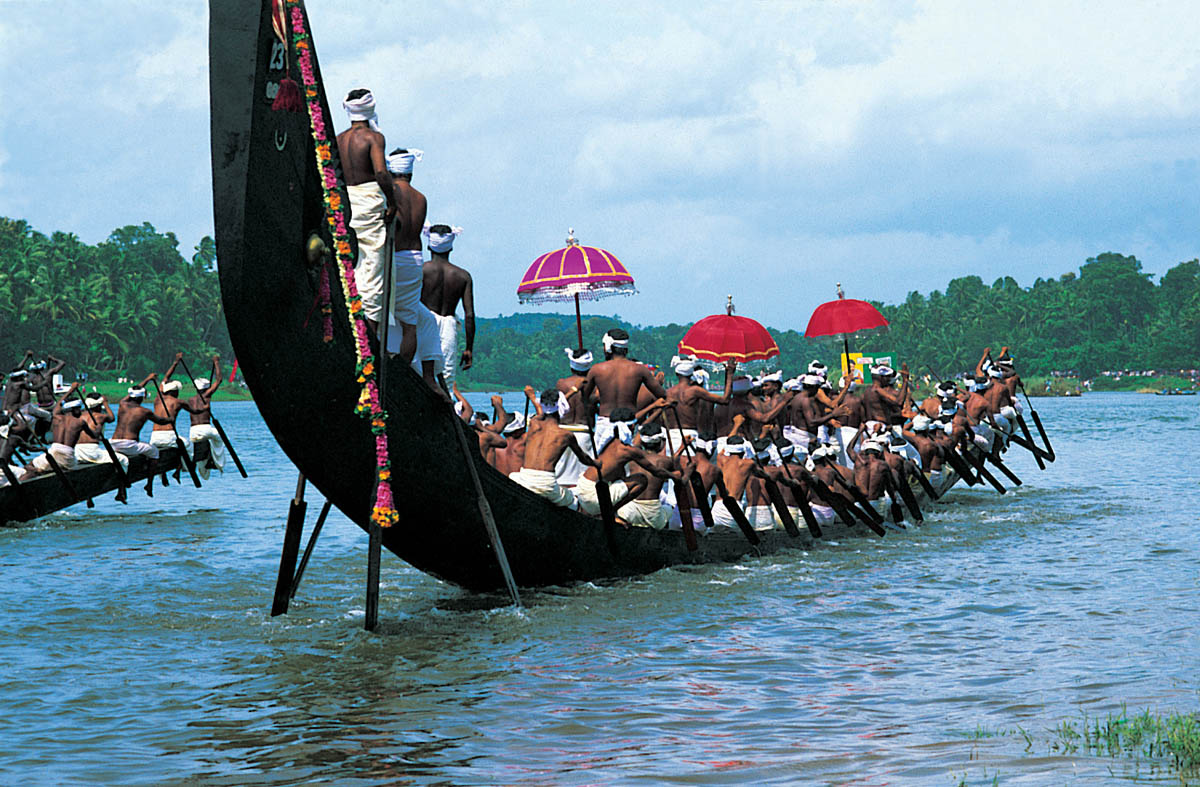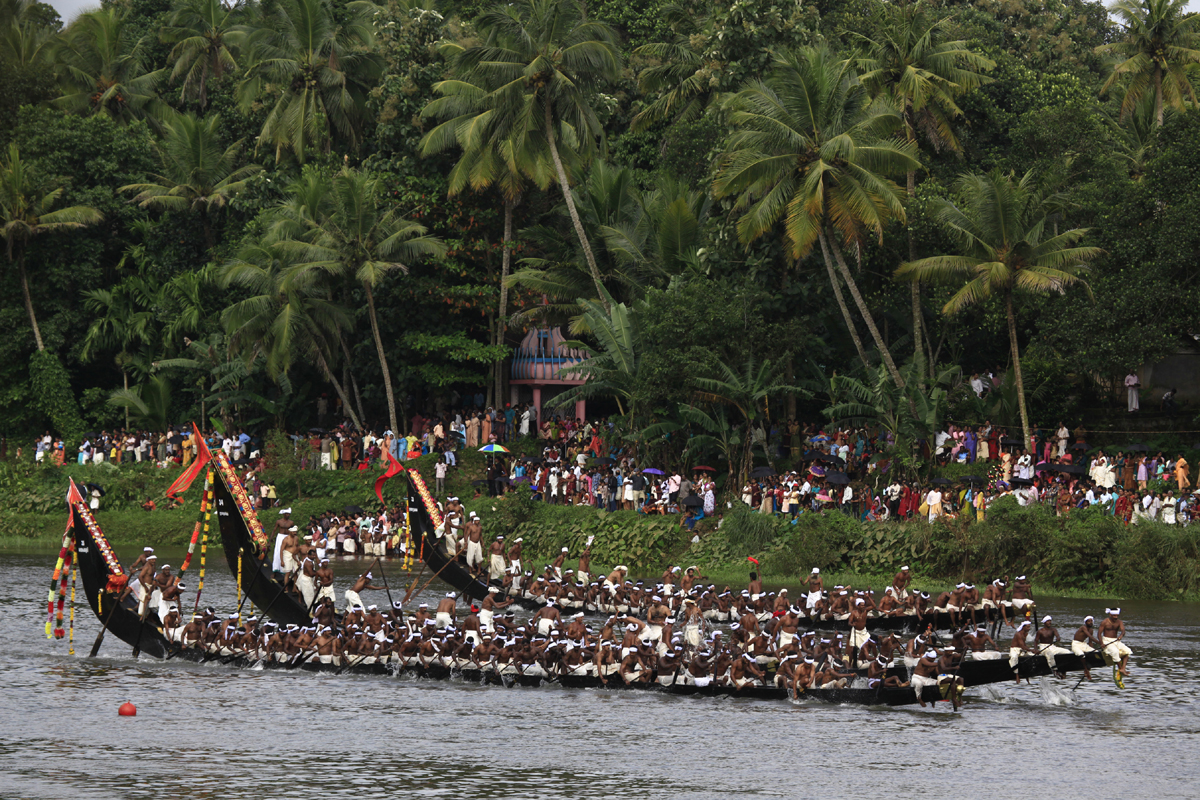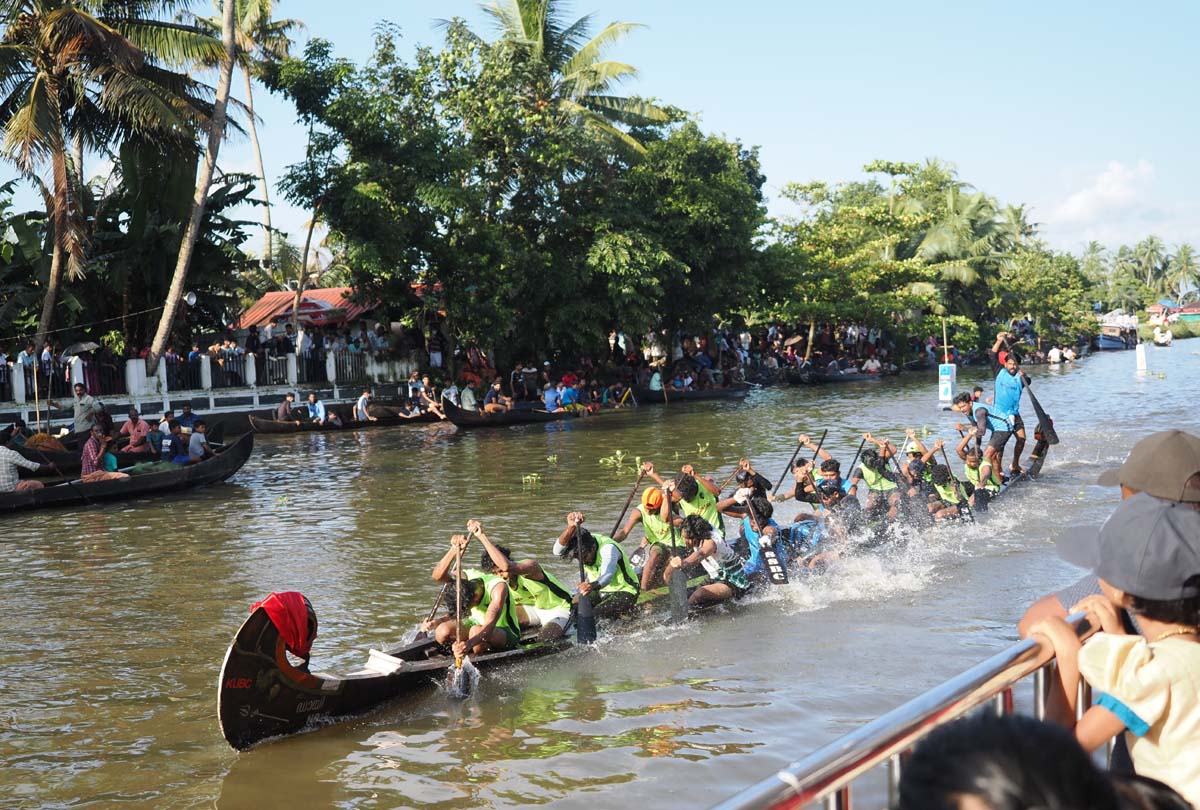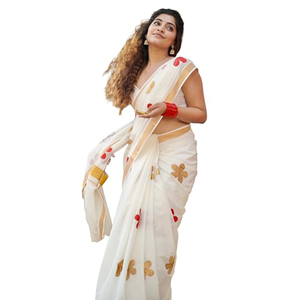Vallamkali: Kerala's Rhythmic Pulse on Water – Folklore and Grandeur

Courtesy: Anjali1840723, CC BY-SA 4.0 via Wikimedia Commons
Kerala, is a land of serene backwaters, lush landscapes, and a vibrant cultural tapestry. Among its most iconic traditions is Vallamkali, the traditional boat race, which transforms the state's tranquil waterways into pulsating arenas of competition and festivity. More than just a sporting event, Vallamkali is a profound expression of Kerala's maritime heritage, community spirit, and deep-rooted cultural pride. While numerous boat races grace the rivers and lakes of Kerala, each with its unique charm, the Aranmula Vallamkali stands out as one of the most ancient and ritually significant, offering a rich tapestry of folklore and cultural depth that perfectly embodies the spirit of Kerala's waterways1.
This article delves into the captivating world of Vallamkali, exploring its historical origins, the legends that breathe life into its traditions, the sacred boats that glide across the water, the rhythmic songs that fuel the oarsmen, and the grand feasts that bind communities. While acknowledging the broader spectrum of Kerala's boat races, we will particularly illuminate the unique customs and spiritual essence of the Aranmula Vallamkali, which serves as a microcosm of this magnificent cultural phenomenon.
The Tapestry of Time: History and Legends of Vallamkali
The origins of Vallamkali are deeply woven into Kerala's historical and mythological fabric, with tales of ancient warfare and divine intervention shaping its enduring legacy.
Early Origins: War Boats and Royal Patronage
The genesis of boat races in Kerala can be traced back to the early 13th century, amidst conflicts between feudal kingdoms like Kayamkulam and Chembakassery2. King Devanarayana of Chembakassery commissioned the construction of the Chundan Vallam (snake boat), a long, elegant war boat designed by skilled carpenters3. These formidable vessels were initially used for naval battles, becoming symbols of power and prestige for local rulers. As peace eventually prevailed, the competitive spirit of these naval exercises evolved into organized races, fostering community unity and regional pride4. The Parthasarathi Chundan, still in use today, is recognized as the oldest surviving model of these iconic vessels5.
The Aranmula Vallamkali: Legends and Sacred Traditions

Courtesy: Department of Tourism, Kerala Govt.
The Aranmula Vallamkali, in particular, is steeped in a rich historical narrative intertwined with divine intervention and communal bravery. Its roots are firmly planted in the sacred narrative of the Aranmula Parthasarathy Temple, dedicated to Lord Krishna6.
The name "Aranmula" itself is steeped in legend, believed to derive from "aru-mula" (meaning "six bamboos"), referring to a raft made of six pieces of bamboo on which Lord Krishna is said to have arrived at the site7. This foundational myth directly links the place to the divine.
Central to this history is the tradition of the Thiruvonathoni (Sacred Thiruvonam Boat). Legend recounts a devout Brahmin, Mangatt Bhattathiri of Kattoor Mangadu Illam, who vowed to provide all the provisions for the Vallasadya feast (Thiruvona Sadya) to Lord Krishna at the Aranmula Sree Parthasarathy Temple annually8. During one such journey, the Thiruvonathoni, laden with sacred provisions, was attacked by bandits. Swiftly, Palliyodams (snake boats) from neighboring "karas" (regions or villages) came to the Brahmin's rescue, protecting the sacred vessel and its precious cargo9. This act of unity and valor is widely believed to have given rise to the tradition of the Aranmula Boat Race, commemorating this protective escort with a vibrant water procession10.
Further reinforcing the divine link, another legend speaks of Lord Krishna appearing in Bhattathiri's dream, instructing him to continue offering the feast at the Aranmula temple. This divine instruction solidified the annual Vallasadya tradition as a sacred act11. The Aranmula Parthasarathy Temple itself holds immense religious significance, believed to be one of five ancient temples in Kerala built by the Pandava prince Arjuna as an act of gratitude for divine assistance during the Kurukshetra war12. The re-dedication of the idol by the goddess Bhumi Devi on Uthrittathi day further connects the race to divine blessings and temple rituals.
These intertwined historical events and profound legends collectively transform the annual Uthrittathi Vallamkali into a deep spiritual offering to Lord Krishna. The race is held annually on the Uthrittathi asterism, which also marks the anniversary of the idol's dedication at the temple, underscoring its sacred rather than purely competitive nature13.
The existence of slightly varying legends regarding Aranmula's origins and its associated traditions highlights that folklore is not a rigid, singular historical record but a dynamic, fluid, and cumulative narrative. These diverse stories collectively serve to legitimize and deepen the sacred and communal significance of Vallamkali and Vallasadya for the people. This living characteristic of folklore demonstrates how cultural memory is constructed, adapted, and sustained across generations through rich, layered storytelling.
The Majestic Vessels: Types of Boats in Vallamkali
Kerala's boat races feature a variety of traditional boats, each with distinct characteristics and historical roles. While the Chundan Vallam (snake boat) is the most iconic, other types also play significant roles in these aquatic spectacles.
Chundan Vallam (Snake Boat)
The Chundan Vallam is the most famous and visually striking boat type, often exceeding 100 feet in length and manned by around a hundred oarsmen14. Its name, "snake boat," comes from its long, narrow shape with a raised prow resembling a snake's hood. These boats are meticulously crafted, often from Anjili wood (a type of jackfruit wood), chosen for its durability and buoyancy. The hull is precisely carved and often painted in vibrant colors, reflecting the pride and heritage of the village it represents. Each Chundan Vallam is revered as its own deity and is owned by a specific village, fostering deep local identity and pride15.
Aranmula Palliyodams:
These are the unique snake boats of Aranmula, distinct from other Chundan Vallams due to their relatively larger and taller structure, allowing up to 15 people to stand in the center. They are considered sacred vessels and are believed to embody the spirit of Lord Krishna16.
Symbolism in Design:
The design of Palliyodams is rich with spiritual symbolism. Nine golden figures attached to the stern represent the Navagraha (nine planets). The sixty-four oarsmen symbolize the sixty-four traditional art forms of Kerala, while the four helmsmen at the rear represent the four Vedas (Rigveda, Samaveda, Atharvaveda, and Yajurveda). The boat's snake-like form is designed to represent Ananthan, the sacred serpent, and Lord Mahavishnu's Ananthashayanam (reclining posture on Ananthan)17.
Other Boat Types
While Chundan Vallams dominate the major races, other boat types also participate in various Vallamkali events across Kerala:
- Churulan Vallam: Smaller, agile boats, often pushed with poles instead of oars, traditionally used by wealthy individuals for travel.
- Iruttukuthi Vallam: Also known as Vadakkan Oddy, these boats are faster and were historically used by pirates due to their speed and low noise. In some races like the Kumarakom Sree Narayana Jayanthi Boat Race, Iruttukuthi boats hold more importance than snake boats.
- Odi Vallam: Lightweight and fast, designed for speed in smaller competitions.
- Veppu Vallam (Vaipu Vallam): Historically used as support boats to carry provisions for soldiers in Chundan Vallams, now also used in competitive races.
- Thekkan Oddy (Company boats): A beautiful boat with a Churulan-like nose and Chundan-like stern, primarily reserved for women's boat races.
- Kochu Vallam: Smaller boats, also participating in races.
The Rhythmic Pulse: Vanchippattu – The Boat Songs
Vanchippattu is the soul of Vallamkali, a traditional form of rhythmic folk song that resonates across Kerala's waterways during boat races and associated festivities18. These songs are far more than mere musical accompaniment; they are integral to the performance and spiritual essence of the event.
Role and Purpose
The primary practical purpose of Vanchippattu is to maintain the rhythm and coordination of the oarsmen, ensuring a smooth and synchronized stroke that propels the massive boats forward. Beyond this, the songs serve to motivate and energize the rowers, boosting their morale and enhancing their performance during the arduous races.
Themes and Significance
The lyrics of Vanchippattu predominantly revolve around themes of devotion, heroism, and rich local folklore. Many songs are heartfelt praises to Lord Krishna, particularly his form as Parthasarathy, the presiding deity of the Aranmula temple19. Other verses celebrate the valor of the oarsmen, the beauty of Kerala's landscape, and narrate historical and mythical tales of the region.
During the Vallasadya feast, Vanchippattu takes on a unique, interactive character: the oarsmen, through the verses of their songs, theatrically request specific dishes from the elaborate spread. A sacred protocol dictates that every dish requested in this manner must be served without refusal. This tradition stems from the profound belief that it is Lord Krishna himself, disguised among the oarsmen, who is making these requests, transforming the act of serving into a direct offering to the divine20.
Musical Structure and Notable Compositions
Vanchippattu features a distinctive rhythmic pattern that perfectly matches the rowing strokes, often employing a dynamic call-and-response format. A lead singer, known as the "Asan," chants the verses, and the entire rowing crew responds in unison, creating a powerful and captivating sound that echoes over the water.
Aranmula boasts its own specific Vanchippattu compositions, enriching its unique cultural fabric. Notable among these are songs like Kuchelavritham, Bheeshmaparvam, and Santhanagopalam. Ramapurath Warrier is revered as the "Father of Vanjippattu," and his work, particularly 'Kuchela Vritham Vanjppatt,' is highly celebrated. This composition, depicting the story of Lord Krishna's childhood friend Kuchelan and his struggles with poverty, is said to have been Warrier's subtle way of conveying his own difficulties to the Travancore King, who reportedly deciphered the hidden message and rewarded him21. The songs are broadly categorized into Vanchippattu and Vachupaatt, sung in different meters (vrithams) like Nadonnatha vritham and Kaakali vritham, each contributing to the rich sonic tapestry of the event.
Major Vallamkali Events Across Kerala

Kumarakam Vallam Kali
Credit: Tonynirappathu,
CC BY-SA 4.0, via Wikimedia Commons
While Aranmula holds a unique spiritual significance, Kerala hosts several other prominent Vallamkali events, each with its own history, traditions, and competitive spirit.
Nehru Trophy Boat Race, Alappuzha
The Nehru Trophy Boat Race is arguably the most popular and competitive boat race in Kerala, held annually on the second Saturday of August in Punnamada Lake, Alappuzha22. Unlike many other races, it is not directly linked to any specific ritual or religious practice. Its origin dates back to 1952 when India's first Prime Minister, Jawaharlal Nehru, was so captivated by an impromptu snake boat race held in his honor that he donated a silver trophy, giving birth to this annual event. The race features majestic Chundan Vallams, with various other categories of traditional boats also participating.
Champakulam Moolam Boat Race, Alappuzha
The Champakulam Moolam Boat Race is one of the oldest Vallamkali events in Kerala, held on the River Pamba on Moolam day in the Malayalam month of Midhunam (June/July)23. This race commemorates the installation of the idol of Lord Krishna at the Ambalappuzha Sree Krishna Swamy Temple. Legend states that the idol, believed to have been given to Arjuna by Lord Krishna, was transported by boat and sheltered overnight at a Christian household in Champakulam to avoid bandits. The race honors this historic procession and the communal harmony displayed.
Payippad Jalotsavam, Alappuzha
The Payippad Jalotsavam is a three-day water festival held on Payippad Lake, near Haripad, during the Onam festival (August/September). This event commemorates the installation of the deity at the Haripad Subrahmanya Swamy Temple. Legend has it that the idol was recovered from the Kayamkulam lake following a divine vision, and villagers ceremoniously brought it back by boat, escorted by other devotees. The festival includes boat processions and culminates in a competitive race.
Kumarakom Sree Narayana Guru Jayanthi Boat Race, Kottayam
Held annually in September during the Vallasadya festival, the Kumarakom Sree Narayana Guru Jayanthi Boat Race commemorates the visit of Sri Narayana Guru, a revered social reformer. In 1903, Guru arrived by boat to consecrate an idol and establish a school in Kumarakom. The race, preceded by a grand procession of country boats carrying a portrait of Guru, remembers this significant event and the enthusiastic welcome he received. While snake boats participate, Iruttukuthi boats hold more prominence in this race.
Kallada Jalotsavam, Kollam
The Kallada Jalotsavam is a popular boat race held on the Kallada River at Munroe Thuruthu, 28 days after Onam (28 th Onam). This annual event features almost all famous snake boats and is organized to promote tourism and water sports, upholding Kerala's traditions. Winners receive the Kallada rolling trophy and cash prizes.
Rituals, Customs, and Community Involvement
Preparation and Sacred Protocols
The construction and maintenance of the Chundan Vallams are labor-intensive processes, often taking months, and are a source of immense pride for the sponsoring village or club. Traditionally, each boat is revered as its own deity and is owned by a single village24. Out of respect for the divinity of these boats, men must be barefoot and dressed only in a loincloth (mundu) while stepping into or handling them. A mixture of fish oil, coconut shell ash, and eggs is applied to the hull to make the boat more slippery and reduce water absorption, with annual repairs carried out by the village carpenter25.
A village leader (kaarnavan or karanaadhan) commands the boat, assisted by three main paddlers who control its movement with a long rudder-oar. The oarsmen, numbering 64 or sometimes 128, sit two to a row and propel the boat to the rhythms of Vanchippattu, led by a cantor standing in the middle section.
Race Day Rituals (Aranmula Specific)
On the day of the Aranmula Vallamkali, the Palliyodams undergo purification rituals and receive blessings at the Aranmula Parthasarathy Temple before participating. The oarsmen, dressed in traditional attire, are escorted into the temple premises upon arrival at the ghats. In keeping with ancient customs, they offer paddy, tobacco, and betel leaves to the deity and then circumambulate the temple, their voices echoing with Vanchippattu, creating a mystical and joyous atmosphere. Their oars and decorated umbrellas are then placed as offerings in front of the temple's main entrance, creating a vibrant display of devotion26.
The Grand Feast: Aranmula Vallasadya
The Aranmula Vallasadya is a culinary marvel, renowned for its sheer scale and the incredible variety of traditional Kerala vegetarian dishes. It is widely recognized as one of the largest vegetarian feasts in the world, attracting an estimated 2 lakh (200,000) people annually to the Aranmula Parthasarathy Temple27. This extraordinary feast typically features an impressive spread of over 60 to 70 dishes, though some accounts mention up to 101 varieties, particularly on special days like Ashtami Rohini, Lord Krishna's birthday. To maintain spiritual purity, all dishes are meticulously prepared without the use of onion or garlic28.
Key Categories and Examples of Dishes
The Vallasadya menu is a comprehensive showcase of Central Travancore's unique vegetarian delicacies. While a full list of all 60-plus dishes is extensive, common categories and examples include:
- Curries and Side Dishes: Parippu (thick lentil dish, often with ghee), Sambar (flavorful lentil-based vegetable stew), Rasam (watery, spicy tamarind-based soup), Pulissery (curry with thick, sour buttermilk), Avial (dense mixture of vegetables and coconut), Kaalan (thick, sour curry of curd, coconut, and vegetables), Olan (light dish with white gourd or black peas and coconut milk), Koottukari (vegetables with chickpeas, coconut, and black pepper), Erissery (thick curry from pumpkin, black-eyed peas, and coconut), Pachadi (sour curry of curd and cucumber or ash gourd), Kichadi (curd-based dish, often with beetroot or pineapple), Thoran (sautéed vegetables with grated coconut), and Mezhukkupuratti (stir-fried vegetables with spices).
- Pickles and Condiments: Injipuli (sweet and sour ginger-tamarind pickle), and various Achar (spicy pickles of raw mango, lemon, or lime).
- Crisps and Snacks: Banana chips (Kaya Varuthathu), Sharkara Upperi (banana chips coated with jaggery), and Pappadam (lentil flour crisps).
- Sweets and Desserts: A variety of Payasams (sweet puddings or kheers), including Ada Pradhaman, Palada Payasam, Moongdal Kheer (Parippu Payasam), Aravana Payasam (rice, jaggery, ghee), Kaalipazham Payasam (banana pudding), and Unniyappam (sweet fried rice cakes). Specific mentions also include Urulakizhangu Pappas (Potato Stew) and Varutha Erissery (Raw Banana and Black Eyed Peas in Roasted Coconut Sauce).
Serving Protocol and Etiquette
The serving of the Vallasadya is a highly ritualized and interactive experience. Dishes are laid out on fresh plantain leaves, following a specific style and defined form.
- The plantain leaf is placed with its narrow portion pointing to the left of the diner.
- Initially, dry items like fried chips (Kaaya Varuthathu), jaggery-coated banana chips (Sharkara Varatti), and a ripe banana are placed on the left end of the leaf. The meal is intended to begin with these dry items and conclude with the banana.
- To the right of the dry items, taste enhancers such as various pickles (Achar, Injipuli) and ginger curries are served.
- From the center of the leaf to the right, accompanying curries like Aviyal, Thoran, Olan, Kaalan, Koottukari, Erissery, Pachadi, and Kichadi are meticulously placed.
- Two types of pappadom are provided: a larger one for the main course with rice, and a smaller one to be enjoyed with payasam.
- Guests are invited to sit after the accompanying curries are served. Then, rice is served. Pouring curries such as Parippu (lentil dish), Sambar, and Pulissery (curd-based curry) are then served in sequence as the diner finishes the previous curry. When rice is first served, it is traditionally divided into two portions: the right side for parippu and the left for sambar.
- After these main courses, several rounds of different payasams (sweet puddings, usually four varieties) are served.
- Following the payasam, rice is served once more, and the meal concludes with buttermilk (Pacha Moru) and Kalan. Finally, the ripe banana can be eaten.
The philosophical logic behind this serving order is rooted in the understanding of digestion: foods that require more time to digest are consumed first, while those that require less effort from the body are eaten last. Sweets are believed to enhance metabolism, aiding digestion and absorption. After the meal, the plantain leaf must be folded inwards, signifying satisfaction and completion.
Taboos and Restrictions
While the Vallasadya is a celebration of abundance, certain traditional protocols and restrictions are observed. Foremost among these is the strict avoidance of onion and garlic in the preparation of any of the dishes, ensuring the spiritual purity of the feast. As highlighted, the most significant "taboo" is the absolute prohibition against refusing any dish requested by the oarsmen through their Vanchippattu. This non-refusal policy is central to the spiritual essence of the Sadya, reinforcing the belief that the requests come from the divine. In modern times, entry to the Vallasadya is often restricted through special passes, and it is explicitly stated that booking through third-party tour packages is not allowed, emphasizing the ritualistic and community-focused nature of the event over commercialization. Furthermore, the Vallasadya is traditionally not held on the day of the Uthrattathi Vallamkali (boat race) or on the main Onam day.
Cultural Significance and Community Spirit
Vallamkali, in all its forms, is more than a festival; it is a vibrant cultural tapestry that highlights the enduring spirit of Kerala.
Symbol of Unity and Devotion
Vallamkali profoundly fosters a sense of community and devotion. It is a celebration where traditional societal distinctions like caste, creed, and social status are often set aside, replaced by the shared joy of faith and festivity29. People from diverse backgrounds, both within Kerala and from across the globe, gather to witness and partake in this sacred offering, embodying a spirit of togetherness that defines the essence of Kerala's traditional lifestyle. The collective effort involved in its preparation and execution, from the building of the Palliyodams to the serving of the feast, underscores a powerful sense of unity and collective identity. The belief that Lord Krishna himself participates among the devotees further strengthens this communal bond, elevating the entire event to a divine communion.
Preservation of Heritage
This centuries-old tradition serves as a vital custodian of Kerala's rich cultural heritage. Vallamkali, along with the Vallasadya, showcases traditional Kerala architecture, intricate wood carvings, ancient murals, and the unique art form of Vanchippattu, preserving practices that might otherwise fade. It is a living, breathing form of devotion, a continuous thread connecting the present generation to the myths, legends, and customs of their ancestors. As a significant part of the larger Onam celebrations, it reinforces the cultural calendar and the values associated with the harvest festival.
Tourism and Economic Impact
Beyond its spiritual and cultural dimensions, Vallamkali is a major cultural spectacle and a significant tourist attraction, drawing thousands of visitors, both domestic and international, to Kerala annually. The event provides a unique opportunity for cultural enthusiasts and travelers to experience a rare combination of ritual and spectacle. The KSRTC Tourism Cell, recognizing its appeal, organizes special trips as part of its Pancha Pandava Temple Circuit, further boosting tourism to the region. This influx of visitors contributes to the local economy, supporting livelihoods and showcasing the unique charm of Kerala's heritage.
Conclusion
Vallamkali, particularly the Aranmula Vallamkali and its accompanying Vallasadya, stands as a magnificent embodiment of Kerala's profound cultural depth and spiritual devotion. More than just the world's longest mass vegetarian feast or a thrilling boat race, it is a vibrant, living ritual that seamlessly weaves together ancient legends, sacred customs, rhythmic boat songs, and an unparalleled culinary experience.
From the legendary rescue of the Thiruvona Thoni to the symbolic design of the Palliyodams and the interactive Vanchippattu requests during the meal, every aspect of Vallamkali resonates with stories of divine connection and communal harmony. It is a powerful testament to unity, faith, and the enduring legacy of a community that continues to honor its heritage with unwavering spirit. Vallamkali is truly an expression of Kerala's soul, offering a unique and unforgettable glimpse into the heart of its folklore and traditions.
References
Websites
- Wikipedia. (n.d.). Aranmula Boat Race.
- Encyclocraftsapr. (n.d.). Chundan Vallam (the Snake Boats of Kerala).
- ResearchGate. (2021). Chundan Vallam: A documentation of the indigenous materials and construction techniques.
- Southtourism. (n.d.). Aranmula Parthasarathy Temple: History, Festivals & Significance.
- Wikipedia. (n.d.). Aranmula Parthasarathy Temple.
- Kerala Tourism. (n.d.). Thiruvonathoni - A Night-Long Odyssey through the Pamba.
- Kerala Tourism. (n.d.). Thiruvonathoni | Aranmula Parthasarathy Temple | Onam Rituals.
- Wikipedia. (n.d.). Palliyodam.
- Aranmula Palliyoda Seva Sangam. (n.d.). Palliyodams - Aranmula Vallamkali - Official Website.
Books
- Muraleedharan, N. (2015). Aranmula Vallamkali. Rainbow.
- India International Centre. (2009). Water: Vanchipattu: Songs of the Boat Race in Kerala. Pearson India.
- Warrier, R. (n.d.). Kuchela Vrutham (Vanchippatu). D.C. Books.
As an Amazon Associate, we earn from qualifying purchases made through links on this site.

